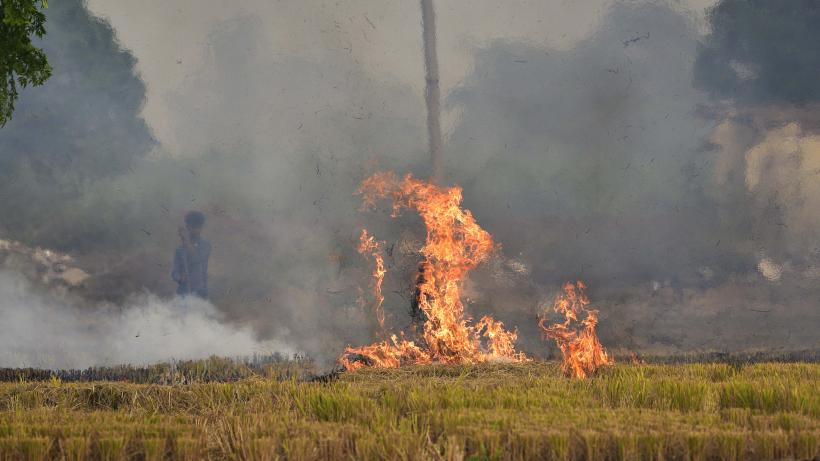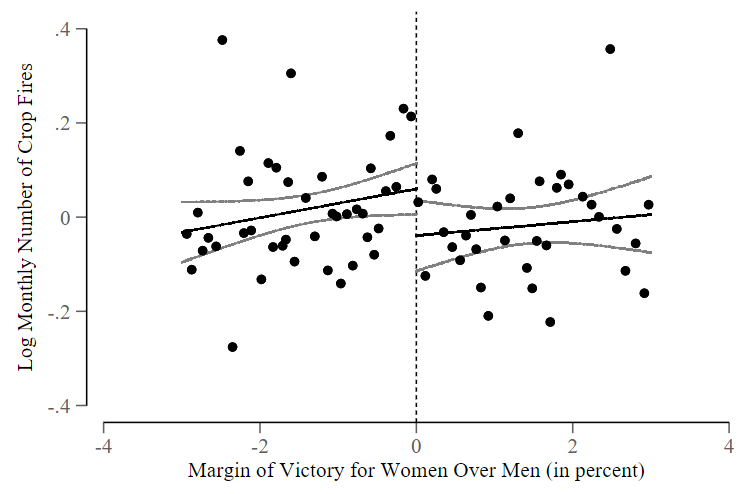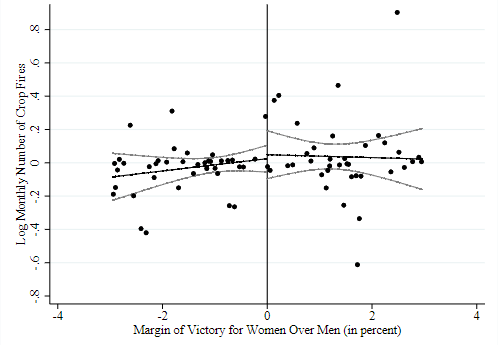
How women leaders save the environment: Evidence from crop fires in India
Women leaders have shown a heightened commitment to environmental matters, and have a crucial role to play in addressing environmental health challenges and risks amid a backdrop of political inertia.
Committed action and dedicated initiatives led by local leaders have the potential to be one of the most effective tools and strategies to address environmental health issues, and push through the political gridlock surrounding widespread environmental degradation. Despite prior evidence indicating a causal relationship between policy and identity, along with survey evidence showing that women often exhibit greater concern for the environment, there remains a significant gap in our understanding of the impact of women leaders on local environmental outcomes. This is the case despite mandatory quotas for women representatives in legislative assemblies in many countries.
Measuring the impact of women leaders on environmental outcomes
In a new study, we use (crop) fire data from India and a close-election regression discontinuity design to provide the first causal evidence that local women leaders improve environmental outcomes. We surveyed 424 female and male village council leaders between December 2022 - March 2023 in Punjab, the state with the highest per capita incidence of crop fires in India. We find that the election of a female legislator over a male legislator in a close election decreases the number of fires by 13% and monthly biomass-related particulate emissions by 40%. We also find that female leaders are more likely to consider crop fires a serious issue, weigh their impacts on child health, support regulation to decrease crop fire incidence, and implement specific crop residue management policies like private residue collection or encouraging crop residue use as fodder.
The use and consequences of crop burning in India
Air pollution remains one of the leading causes of mortality, accounting for 9 million premature deaths annually or roughly 16% of all deaths worldwide, and a staggering 268 million disability-adjusted life-years. Nowhere is the problem more pronounced than in India, which is home to 14 of the 20 most polluted cities in the world. In fact, if the city of New Delhi, the capital of India, were to meet World Health Organization air quality standards, average life expectancy would increase by 10 years, roughly equivalent to the country’s average life expectancy gains in the 21st century. While there are various factors contributing to poor air quality year-round (such as vehicular emissions), crop fires are a seasonal but acute factor that exacerbate the issue, accounting for as much as half of the particulate pollution during the winter months.
Farmers in India use crop fires for three reasons: (i) clearing harvest residue off fields in preparation for planting in the next season, (ii) making sugarcane harvesting less labour-intensive, and (iii) clearing undergrowth on fields left fallow between cropping seasons.
The use of fire is particularly prevalent where there are coupled rice-wheat cropping arrangements – a widespread agriculture system across India. In this system, farmers grow rice during the monsoon season (Kharif) from June to November and wheat during the winter season (Rabi) from January to May. A narrow window of time between the harvest of rice (in October-November) and the planting of wheat (in December-January), and between the harvest of wheat (in April-May) and planting of rice (in June-July), requires large-scale and quick removal of crop residue. Setting fire to crop residue is particularly quick and helpful in this process.
Fire also plays a role in the production process for sugarcane – an important crop across the country. Farmers light sugarcane fields (in December-March) to remove the outer leaves around the cane stalk before harvesting. This makes the process easier and requires less intensive manual labour. Finally, the use of fire is widespread alongside forest lands in central and north-east India that follow shifting cultivation, where fields are left fallow for more than a year, and farmers switch between alternate plots of land. Undergrowth often overtakes fallow fields, which need to be cleared before the subsequent season's planting.
Alternative mechanisms like labour and mechanised equipment are available to farmers. However, farmers prefer the use of fires because they are cheaper, despite the associated human health costs. In our survey of 424 village council leaders in Punjab, India – a majority of whom earn their livelihood through agriculture – more than 50% of respondents said that the use of both labour and machines was more expensive, even though they recognised that crop fires negatively affect health outcomes.
Women in Indian state legislatures and incidence of crop fires
To examine the effect of women leaders on crop fire incidence, we use satellite data on the number of fires – as captured via NASA’s Terra and Aqua satellites – in state legislative assemblies across India; we compare assemblies where women narrowly won or lost elections against men from 1998 to 2022.
The elected members of state legislative assemblies in India, known as MLAs, play a pivotal role in shaping public health and agricultural policies, influencing the allocation of federal funds to local administration for effective policy implementation, and overseeing the progress and enforcement of these policies. However, a glaring disparity exists in women’s representation in federal and state politics in India. Recent statistics show women’s representation hovering around a meagre 10%. This is particularly significant because female MLAs have distinct policy priorities compared to their male counterparts, with a marked preference towards increased investments in child health and education.
Women leaders decrease crop fire incidence and particulate emissions
We find the election of a female MLA over a male MLA in a close election decreases the number of fires by 13% (Figure 1) and monthly maximum biomass-related particulate emissions by 40%. A key assumption underlying our research design is that there are no other differences between constituencies where women narrowly won over men and where women narrowly lost to men. In fact, we observe that elections with a narrow female winner share similarities with elections where women narrowly lost such as the candidates’ party affiliation, education, and number of votes. Similarly, assemblies with a narrow female winner exhibit similar characteristics to those with a narrow female loser including factors like electricity access and the number of schools among others.
Figure 1: Incidence of crop fires in all assemblies where women narrowly won or lost

Figure 2a: Incidence of crop fires when women narrowly won or lost in assemblies with high rice and sugarcane

Figure 2b: Incidence of crop fires when women narrowly won or lost in assemblies with low rice and sugarcane

Notes: i) All graphs plot the regression discontinuity relationship for log of monthly fire counts. ii) High and low rice and sugarcane indicate assemblies which had high (above sample median) share of cropped area under rice or sugarcane at baseline and low (below sample median) share of cropped area under rice and sugarcane at baseline, respectively.
Furthermore, in a placebo test, we demonstrate that there are no differences in either fire incidence or particulate emissions before a woman's close electoral victory over a man. We also find that the reduction in fire incidence and particulate emissions is concentrated around the winter harvest and post-harvest months in districts that follow fire-suited cropping patterns (left panel of Figure 2), with comparatively modest effects in districts that do not follow fire-suited cropping arrangements (right panel of Figure 2). Lastly, the decrease in fire incidence and particulate emissions in districts that follow fire-suited cropping patterns is concentrated during the harvest and post-harvest months, with null effects during the rest of the year.
Women leaders are more concerned about crop fires
To shed light on mechanisms driving these observations, we conducted telephonic surveys with 230 female and 194 male village council leaders (VCLs) between December 2022 - March 2023 in Punjab, India. Though VCLs are not equivalent to MLAs (with whom it was not possible to schedule interviews), they share analogous roles and responsibilities at a more grassroots level. These local leaders are responsible for implementing state policies and discerning the needs of the villages they represent. While their primary financial backing comes from the state, they are granted, in theory, total autonomy in the disbursement of these funds. It is important to note that Punjab ensures a 50% reservation quota for women in VCL elections, especially since prior evidence has shown that reservation for women causes an uptick in investments directed toward public goods benefiting women and children.
We find that women leaders are 20% more likely to consider crop fires as a serious problem, plausibly because they are more concerned about the health costs of crop fires for children. Accordingly, we observe that women leaders are 50% more likely to be worried about the child health impacts than male leaders. Furthermore, women leaders are more likely to strongly favour regulations to decrease crop fire incidence. They also have more awareness of the policies implemented by the government to tackle this issue (such as penalties). Finally, women leaders have a higher likelihood of promoting and implementing policies like crop residue management, private residue collection, and encouraging the use of crop residue as fodder. This is significant, as private residue collection has been shown to decrease the incidence of crop fires elsewhere. These results are robust to controlling for differences in demographic characteristics between male and female VCLs such as education, age, and occupation.
Implications for economic development and environmental policy
The interplay between economic development and environmental policy presents complex challenges. As economies flourish, a surge in production and consumption ensues, which, at least initially, exacerbates pollution and environmental degradation. Merely formulating policies to counteract these adverse environmental externalities might fall short of achieving the desired impact, especially in contexts with weak regulatory institutions and inconsistent enforcement. What is crucial is the presence of dedicated leaders who are genuinely committed to implementing these policies on the ground. Our results suggest that enhancing women's political representation might help developing countries navigate existing and emerging environmental challenges.
A version of this article was published in Ideas for India.

